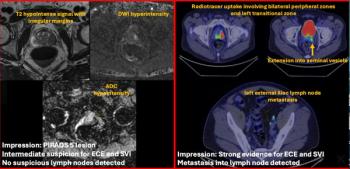
GE moves Maximum Resolution upgradeto Logiq 400 and 500 ultrasound units
Vendor reports that Logiq 700 MR sales are boomingGE Medical Systems this week announced that it has adapted theLogiq 700 Maximum Resolution upgrade unveiled earlier this yearto scanners in lower price points. GE officials say similar
Vendor reports that Logiq 700 MR sales are booming
GE Medical Systems this week announced that it has adapted theLogiq 700 Maximum Resolution upgrade unveiled earlier this yearto scanners in lower price points. GE officials say similar migrationswill be repeated in years to come as the Milwaukee vendor debutsadvanced technologies on Logiq 700 and moves them to its otherultrasound platforms.
GE introduced the Maximum Resolution upgrade in April, hopingit would finally give the Logiq 700 scanner the respect that GEbelieves it deserves (SCAN 5/8/96). The technology consists ofhardware and software upgrades that improve spatial resolutionand color-flow sensitivity.
Those technologies are now available on Logiq 500 and Logiq400, which as a result will carry the suffix "MD," accordingto Jeff Peiffer, manager of ultrasound marketing. The upgradeis standard on all new scanners and is available as an upgradeto systems in the field.
The two main components of MD are Micron Imaging and AdaptiveColor Enhancement. Micron Imaging is GE's term for a combinationof high-frequency imaging capability and new image-processingtechniques that enable levels of resolution fine enough to bemeasured in microns rather than millimeters, according to BillKyle, product marketing manager.
At present, Micron Imaging can be used only with GE's new LA39transducer, a wideband 6 to 13-MHz probe. The technique is designedfor applications in musculoskeletal, breast, testicular, and othertypes of small-parts ultrasound.
"Before, you saw things on the millimeter scale -- you'dmeasure resolution and objects in millimeters," Kyle said."Now we are below that. We are seeing and measuring and resolvingon the micron scale."
Adaptive Color Enhancement (ACE) applies new signal-processingalgorithms to improve color-flow Doppler sensitivity on Logiq400 MD and Logiq 500 MD scanners. ACE differs from standard color-flowtechnologies in that conventional color-flow employs algorithmsthat build their color displays based on measurements of the meanor average Doppler frequency shift. ACE, on the other hand, usesthe entire Doppler spectrum to create its color-flow display,according to Peiffer.
"We are looking at the entire shape of the spectrum, becausethere is more information in the Doppler spectrum than just themean frequency," Peiffer said. "You can make more intelligentdecisions in your image processing, and therefore get better sensitivityand (less) motion discoloration."
ACE can be used with all Logiq probes and applications.
In addition to ACE and Micron Imaging, GE is rolling out newcardiac probes for Logiq 400 and Logiq 500. The company is releasinga new 3.5-MHz wideband sector probe and a new 6-MHz wideband sectorprobe. In the surgical realm, GE is releasing two new intraoperativeprobes for vascular and abdominal applications.
To acquaint clinicians with the MD upgrade, GE plans to launcha road show this month, with the first date scheduled for Oct.15 in Atlanta and subsequent appearances in Los Angeles, New York,and Chicago. The upgrade and the new systems began shipping thismonth.
GE hopes the MD upgrade will be as successful for the Logiq400 and 500 scanners as MR has been for Logiq 700, which finallyappears to be living up to the initial hype GE gave the systemwhen it was rolled out in 1993 (SCAN 12/15/93). Sales of the super-premiumscanner have more than quadrupled since MR's April debut, accordingto Peiffer.
"It was better than we had expected. We've had two recordmonths in the last two months," he said. "Customersrecognize that GE has something that is different and better thanthey've ever seen. "
Newsletter
Stay at the forefront of radiology with the Diagnostic Imaging newsletter, delivering the latest news, clinical insights, and imaging advancements for today’s radiologists.




























